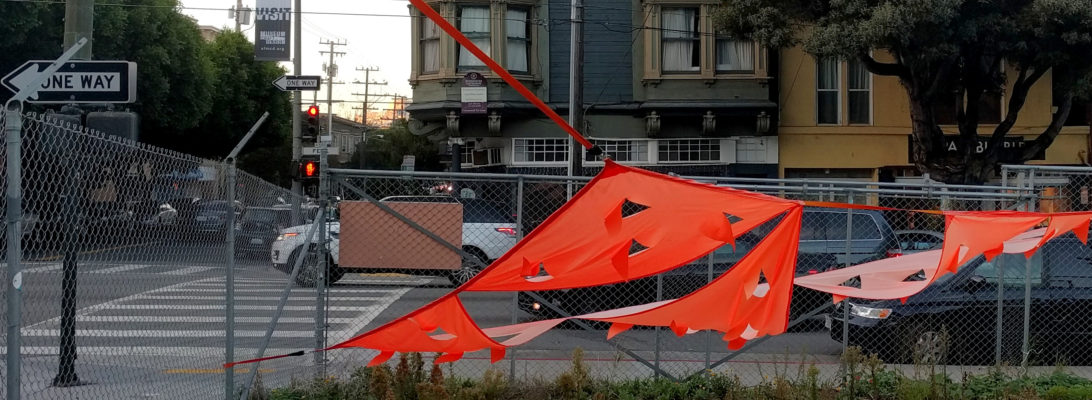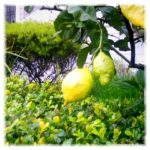Miner’s Lettuce – once I read about it, it was hard not to miss it on my walk! Bright green cups with tiny white flowers nestled inside – almost looks like a candidate for one of those Victorian era fairy illustrations, doesn’t it? I didn’t eat it.
garden
Springtime green lemon on golden gate
What is this pretty tree blooming in the rain (and shading my back garden space..)
Great little thought piece on the cultural background behind garden cities and building public parks – like SF’s.
If you’re thinking of ripping up some concrete in Western Addition/NOPA count me in!

Not only would this help with the streams of urine, dog feces, motor oil infested riffles of water coursing down every available surface when it rains – it looks quite nice too and would provide a LOT more light to grow plants than my current situation. How much do I want a sidewalk garden now!?
Found this great list of plants that will love growing in your San Francisco parklet, sidewalk garden or balcony! http://bit.ly/gelOOv
I will come to your neighborhood to help you build one, or let me know if you live near Western Addition/Divisadero. There are a lot of candidate corners over here!
If you like parks and greening unused space in SF, join me volunteering?
Check out the SF Parks Trust projects page here… pretty cool, huh? I plan to sign up to volunteer. Ever walked by an empty yard in a business, a brown corner filled with trash, an unused curb space and want to plant something it it?
Miner’s Lettuce
Never really heard of miner’s lettuce before – apparently it’s in season RIGHT NOW in Northern California. I’ll keep my eyes open this weekend when I head up past Nevada City for a night of winter hut camping! I have a feeling with this weekend’s forecast, however, it might be buried in some below-the-snowline flakes!!

Click for link to photo credit
Here’s a succint little history on the plant from Hank Shaw where you can learn about this native plant that’s so delicious to eat. If I can’t forage some, maybe it will be a good candidate to grow in my shady back yard?
Any experienced SF shade gardeners out there??!!
Hi, I need help figuring out what on earth will grow behind my apartment building! It is between two other buildings and has a giant tree overshadowing it. I think it gets very little if any light. I am learning that little, if any, food products will grow back there. I’m hoping for sorrel, mustard, and spring greens once the days get a little longer – with 13+ daylight hours, I hope enough can filter through for growth. In the meantime, I’d really like to find some fun and pretty woodland type plants I could grow back there. It’s just a wasteland of leaves from the tree and three varieties of weeds (they’re all green, so SOMETHING can photosynthesize back there!) and a bunch of raw dirt that nothing’s growing on. Here’s a view from above, looking down on the “garden” from my apartment window: 
It’s pretty useless for recreating, because who wants to go out on a nice day and grill and hang out in a shady, dank yard, where all your neighbors can hear you? Thus, I’d like to do something with is, since my landlord gave me free reign (currently it’s a wonderland of leaves, abandoned bikes, bits of brick, and the aforementioned green weeds). What do you think can grow back there that might look nice? Obviously, I always prefer “edible landscapes”, especially herbs and such, but I’m not sure anything will thrive.
Here are some plants I looked up online that might grow, but I need to know: Are they the best choice? Where do I buy them?
- Arugula
- Mints
- black snakeroot and bleeding heart (not sure what these entail)
- hosta lilies (probably a good choice – where to buy?)
- wild violets and lily of the valley (woodland plants – can you buy them?)
- ferns (no idea where to get)
- nettle (white nettle is edible – i might try this. not sure where to buy it)
I’ve also been reading this ridiculous garden-porn book (it’s all-color, including the text, and features so many cool urban and small space gardening ideas – tons of photos, written by a brit, and published by chronicle – called “Garden Anywhere”) but apparently this doesn’t include urban gardening for people who *don’t* have balconies, front ledges, yards, or stoops. SIIIIGGGGH. I have at least one book “Gardening in Small Spaces” that at least *acknowledges* this is the reality in many urban environments, but sadly, it appears that his solution was to “grow” his own food in the form of sprouts, mushrooms, fermented things like kimchi and sauerkraut. All can be good, but not really what I’m looking for.
Time for some ill fated spring planting

Although I already know that nothing grows back there but these wierd low-to-the-ground sticky/hairy weeds and plantlets from the overhanging tree. However, I decided to plant some new seeds anyway, now that the days are a little longer. I threw some seeds into the raised bed – red garnet mustard, swiss chard, dill, and sorrel. I also planted another round of field peas. Hopefully they come up – the microgreens already in there were planted in mid-November, though admittedly it’s been winter.
Slow Food or Slow Cities – or both?

Picture credit – KQED San Francisco Blog
I can’t decide which topic I’m more interested in as a focal point/lens through which to view sustainability issues – cities or food! I love that the “food movement” has now coalesced to the point where it encompasses not only issues of flavor and gourmet cooking, but also fossil fuel use, transport, food heritage, health, school lunches, “food deserts”, botany, home gardening, food science, and economics. If you can get past the more extreme viewpoints and move past the elitism of some arguments, I find that looking at a food is a wonderful focal point through which to look at a lot of important contemporary issues surrounding, health, income disparity, and culture. I’m also passionate about the idea of sustainable cities – how they can look and how we can get there – which is a similarly all-encompassing way to view issues of urban planning, public-private partnership, transit, health, climate change planning, international partnership and gardening. I also love how both of these issues overlap when you look at how food and cities interact – not just in the high concentrations of great restaurants, markets, and the burgeoning street food trend – but also in terms of getting more plants into the ground and balconies of American cities, and cleaning up the water and surface runoff so that flora and fauna around our urban areas aren’t full of bioaccumulated toxins. I already love to cook and ready about city history, but how much happier would I be if I could rip up half of the sidewalk pavers in my neighborhood and plant some gorgeous edible herbs and even set up some picnic tables so neighborhood residents could escape their dark little apartment boxes to sit outside on a sunny day and enjoy a homecooked meal?


